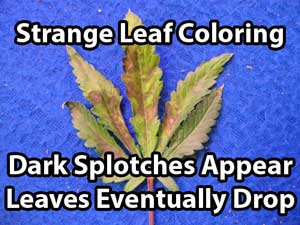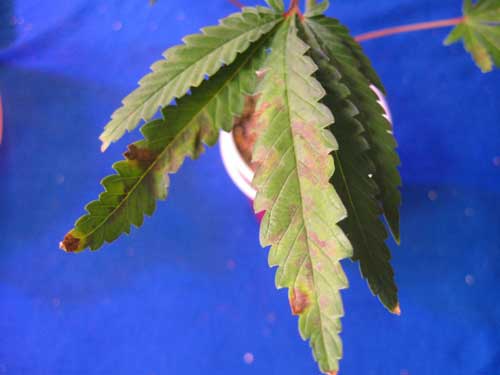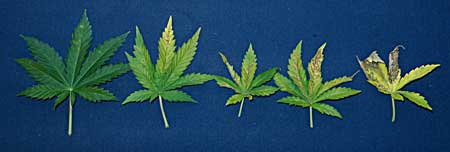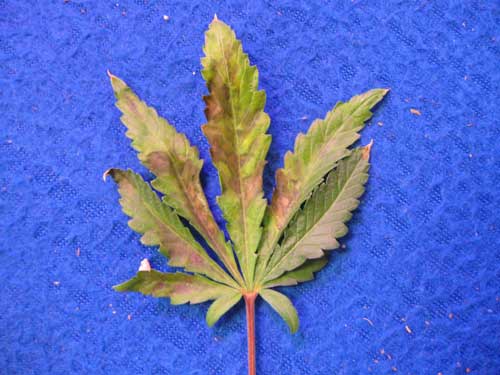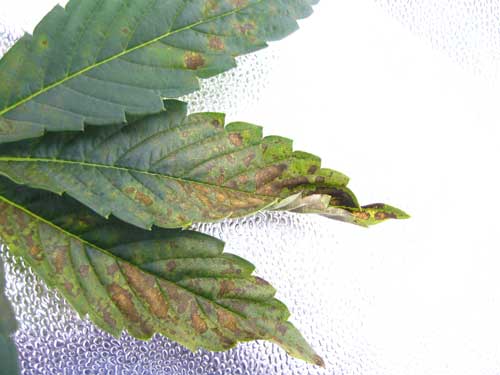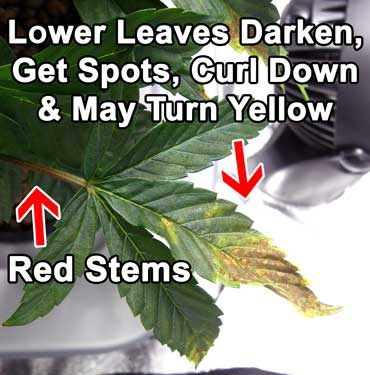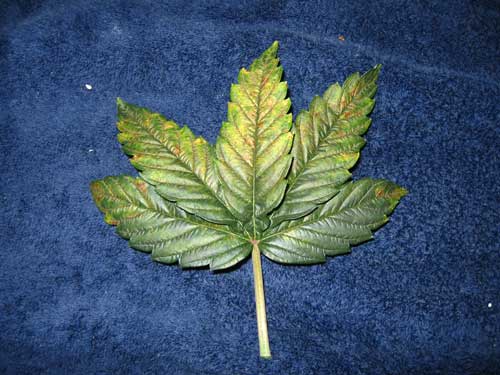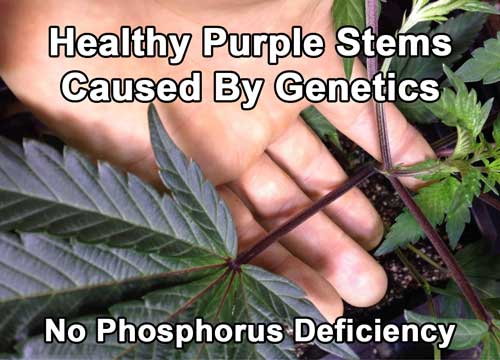Phosphorus, is a mobile nutrient and is considered vital for plant health. Numerous catalytic process involving photosynthesis and energy transfer within the plant require adequate amounts of Phosphorus. Phosphorus needs to be readily available at all stages of life, and in even higher concentration in flower, transplants or rooting.
Phosphorus is a major component in creation of ATP an organic molecule that is crucial for transport of different ion between cell membranes. Without optimal levels of Phosphorus many things can’t happen, photosynthesis, growth, reproduction.
Common visual sign of a phosphorus deficiency might be;
- Seen in lower and older leaves of the plant first
- Seen as Shiny/Dark that develop spotting and die
- Common sources of issues not enough Phosphorus when needed, or improper pH.
- leaves get bronze, purple or brown spots and splotches
- thick dry leaves die and become stiff and brittle
- stems sometimes turn bright red or purple, but not always
The Beginning stages of a Phosphorus deficiency to the end seen here. Dark green to discoulered tips leading to bend burled leaves and eventually death.
Cannabis uses an abundance of phosphorus in flowering/budding stages. Nearly all nutrients formulated to flower cannabis will come with plenty of phosphorus for your plants, but remember mid stage flowering plants will benefit from extra P.
So if you’re seeing a phosphorus deficiency in cannabis while using standard cannabis nutrients, chances are you actually have an issue with availability, antagonism and or nutrient competition.
In the beginning and throughout the end of flowering, cannabis require large amounts of readily available Phosphorus to maintain growth and optimal photosynthesis in late flower. Often needed as a supplement to aid fruiting/ripening stage usually stopping additive use by hardening staging. Products like bud boost or P/K etc when used in mid flower will not only increase fruiting mass/plant size but also terpene profiles when used correctly.
Phosphorus is one of the major 3 nutrients and while it has a role in energy transfer, intercellular nutrient movement, photosynthesis, catalysts of starches and sugars as well as genetic characteristics shared from one generation to the next.
Problems can arise simply because of a pH imbalance or nutrient antagonism. Commonly Phosphorus issue can arise when in the presence of large amounts of minors like zinc, boron and trace metals like Iron . And is known to be antagonistic with calcium, potassium.
So when you notice signs of phosphorus deficiency make sure your other macro, micros are in balance. Damage once set wont repair itself.
The leaf below was at the bottom of the plant and turned dark green and glossy appearance, with a bluish tinge. Cannabis phosphorus deficiencies usually appear on the lower/older parts of the plant. The leaf then started showing spotting a sign of a progressing of a phosphorus deficiency. Where the surface of the leaf is touched by light it will began to curl and turn yellow.
Notice that the stems or veins never turned red or purple on this leaf, this leaf is only showing signs now, this damage can be reversed by flushing your media and making a new solution of balanced feed solution for the plant. In some stages of life they will need much more phosphorus but keep in mind not more than other nutrient’s that accompany it in you nutrient lines. Often as plants get older the proportion of available nutrients is not what it’s using, leading to nutrient waste and deficiencies. Try to add more P with a phosphorus only product or a traditional Pk booster.
The early progression of a phosphorus deficiency can be seen as a healthy leaf with slight spotting and discoloration yellowing, that will eventually kill the leaf. If you see these other symptoms with red and purple stems this may further suggest signs of a phosphorus issue.
Also in other interaction in your media, a healthy plant with optimal conditions can quickly lead to deficiencies through synergistic effect between nutrient’s in your media.
The synergistic relationship between Nitrogen and Phosphorus means uptake of one requires the other. This can be an issue as Nitrogen can be leaned on heavily in nutrient lines leading to a lack of phosphorus. This can simultaneously happen as you are having antagonistic effects from boosted or top feeds designed to deliver large amounts of potassium or calcium but not phosphorus.
Solution For Cannabis Phosphorus Deficiency
1.) Adjust pH to Correct Range
Your cannabis plant may show signs of a phosphorus deficiency due to a low or high soil pH, ensuring at the roots that it is unusable. That is because when the pH of your root zone is off, your cannabis cannot properly absorb phosphorus as a high enough rate. So step one is always to attempt to balance your soil/media pH to a level that allows easy absorption. See below.
Phosphorus is best absorbed by cannabis in soil at a root pH of 6.2 – 7.0. Phosphorus is best absorbed by cannabis in hydro at a root pH of 5.5 – 6.2. If you believe you have a cannabis phosphorus deficiency, it’s important to check the pH of your root zone to make sure the deficiency isn’t caused by the pH being too high or too low.
If you suspect your growing cannabis plant has a phosphorus deficiency, flush your system with clean, pH’d water at 3 times the volume of your media, if in hydro simply wait a few hours, change out water once more and introduce a full strength solution.
2.) Give the Right Nutrients
Most growers have actually already given plenty of phosphorus to their cannabis plants since it is found abundantly in quality soil and cannabis-friendly nutrients. However, even if you are giving phosphorus, it’s important to give your cannabis the right ratio of nutrients.
Because of nutrient antagonism and how your nutrient lines are formulated you may need too feed at lower rates ad boost your feeds with whats missing. Remembering to keep minors low and a decent level of nitrogen to help transport your phosphorus.
Flush your plant thoroughly with properly pH’ed water and then charge with a full-strength dose of pH correct nutrients.
Sources of phosphorus other then bottle nutrient’s:
- Bat guano (phosphorus is readily available, especially if made into a teat)
- Bone or blood meal (takes quite a bit of time to break down in soil unless made into a tea first)
- Worm castings or worm tea
- Soft Rock Phosphate
- Fish meal
- Crabshell
- Most cannabis-friendly “bloom” or “flowering” nutrients contain high levels of phosphorus to aid in flower production, and phosphorus from a liquid nutrient is one of the most readily available forms of phosphorus you can provide to your cannabis plants
All of these amendments effectiveness will be determined by particle size and quality. Always get high quality ingredients and always get them at a particle size that suite your plants needs. Larger particles sizes tending to take longer to break down and disperse being less readily available for longer periods. And smaller sizes being more readily available and also not lasting as long.
Adding these to your media should be done selectively, as rule of thumb its easier to add then to take away. And phosphorus damage can be permanent, with that said its not a very common occurrence as plants usually love P.
3.) Watch for Recovery
After going through all the above steps, watch to make sure that the phosphorus deficiency starts to clear up within a few days to a week or so. After a phosphorus deficiency is cleared up, the problem (brown spots, unhealthy lower leaves, red/purple stems, etc) will stop appearing on new leaves, usually within a week.
Severely damaged leaves will not bounce back but as long as you have corrected the source of the nutrient imbalance you should see healthy new growth

